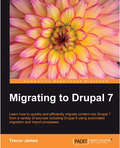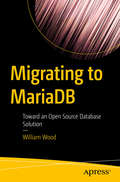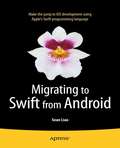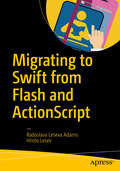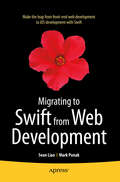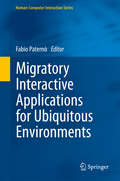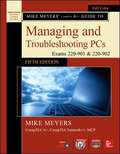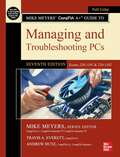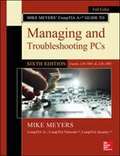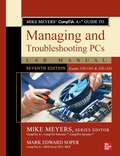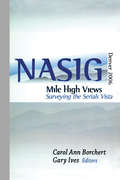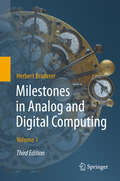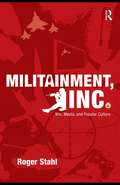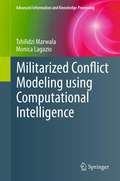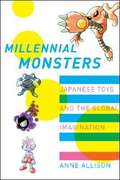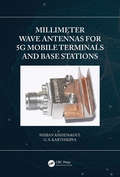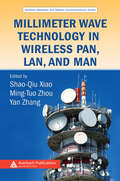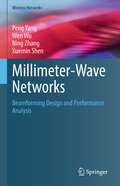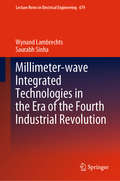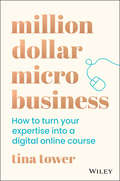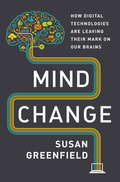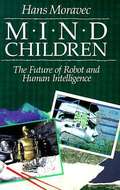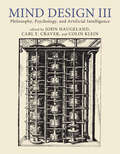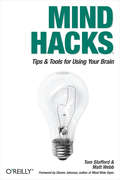- Table View
- List View
Migrating to Drupal
by Trevor JamesWritten in a friendly and engaging style with practical tutorials and step-by-step examples which show you how to easily migrate your Drupal 6 or WordPress site to Drupal 7. "Drupal 7: A Guide to Migration" is for anyone interested in how to move content from an existing website into the Drupal content management system. Both novice and advanced Drupal users will gain practical hands-on knowledge in how to migrate content into Drupal using this book. You will become experts in using the Feeds module to migrate content, and in packaging your code using Features.
Migrating to MariaDB: Toward An Open Source Database Solution
by William WoodMitigate the risks involved in migrating away from a proprietary database platform toward MariaDB’s open source database engine. This book will help you assess the risks and the work involved, and ensure a successful migration. Migrating to MariaDB describes the process and lessons learned during a migration from a proprietary database management engine to the MariaDB open source solution. The book discusses the drivers for making the decision and change, walking you through all aspects of the process from evaluating the licensing, navigating the pitfalls and hurdles of a migration, through to final implementation on the new platform. The book highlights the cost-effectiveness of MariaDB and how the licensing worries are simplified in comparison to running on a proprietary platform.You’ll learn to do your own risk assessment, to identify database and application code that may need to be modified or re-implemented, and to identify MariaDB features to provide the security and failover protection needed by corporate customers. Let the author’s experience in migrating a financial firm to MariaDB inform your own efforts, helping you to develop a road map for both technical and political success within your own organization as you migrate away from proprietary lock-in toward MariaDB’s open source solution. What You'll LearnEvaluate and compare licensing costs between proprietary databases and MariaDBPerform a proper risk assessment to inform your planning and execution of the migrationBuild a migration road map from the book’s example that is specific to your situationMake needed application changes and migrate data to the MariaDB open source database engineWho This Book Is ForTechnical professionals (including database administrators, programmers, and technical management) who are interested in migrating away from a proprietary database platform toward MariaDB’s open source database engine and need to assess the risks and the work involved
Migrating to Swift from Android
by Sean LiaoIn 250 pages, Migrating to Swift from Android gives you--as an experienced Android app developer--all you need to create native iOS apps using the latest Swift programming language. Starting with preparing your Xcode 6. 1 IDE and introducing just enough iOS application framework fundamentals, you'll understand how to create meaningful Swift applications for iOS 8 immediately. After the short IDE setup guide, this book continues by providing guidance on how to translate your existing Android apps to iOS. Every topic comes with a tutorial project; you'll plan and structure your iOS apps following a typical top-down process using Xcode Storyboards. To implement use cases, you'll cover common mobile topics, including user interfaces, managing data, and networking with remote services. As you move through Part 2 of this book, you'll create simple and meaningful iOS apps with rich UI components to handle common CRUD operations locally and remotely. Part 3 demonstrates the whole porting process by translating a typical mobile app from Android to iOS 8 from start to finish. When you finish reading Migrating to Swift from Android, you'll be an iOS developer as well as an Android developer. And, you will be fully convinced you can create iOS apps just like you do in Android. In most cases, it is a waste not to port your native Android apps to iOS. What you'll learn Maximize your existing mobile knowledge to learn iOS programming Use the latest Xcode 6. 1 IDE Translate your existing GUI Android apps Learn the fundamentals of Swift Work with user interface components and UI animations Store and retrieve data Create networked apps that use remote services Who this book is for This book is for Android developers wanting to make the jump to iOS development using the new Apple Swift programming language. Table of Contents Part 1: Prepare Your Tools 1. Setting Up the Development Environment 2. iOS Programming Basics Part 2: Come Sail Away: A Roadmap for Porting 3. Structure Your App 4. Implement Piece by Piece Part 3: Pulling It All Together 5. Recap with a Case Study
Migrating to Swift from Flash and ActionScript
by Radoslava Leseva Adams Hristo LesevBuild on your knowledge of ActionScript to take the fast track developing iOS apps with Apple's latest language, Swift. Swift's syntax is easier to understand than Objective-C for people already familiar with ActionScript. At the same time it offers a number of new features and richer expressiveness than both ActionScript and Objective-C. Switching to a new platform usually involves migration on three levels: tools, workflow, and programming language. This book is structured as a guide that will help you on each level with step-by-step tutorials. Apart from the tutorials, it comes with recipes for some of the most popular mobile development topics: social network integration and messaging, taking advantage of device capabilities, networking and working with local and iCloud data, advertising in your app or game, and 2D and 3D graphics. The book also includes a final chapter that takes you through Apple's App Store submission process. Don't just build your apps, sell them. What You Will Learn: Expand your development knowledge to native iOS programming with Swift Use the latest Xcode 7 IDE Migrate your existing ActionScript projects to Swift Create advanced UI, leverage the device hardware, integrate with social networks, take advantage of 2D and 3D graphics Diagnose your app quickly with Xcode's debugger and instruments Prepare and submit our iOS app in Apple's App Store Who This Book is For: Migrating to Swift from Flash and ActionScript is for Flash and Adobe AIR developers who want to move on to native iOS programming with the latest Apple Swift language. It's for the seasoned ActionScript programmer who is looking to add another language and platform to their tool belt quickly. Migrating to Swift from Flash and ActionScript is a good choice for developers who learn by doing and don't have time to read thick manuals and books for beginners in order to start programming in a new language.
Migrating to Swift from Web Development
by Sean Liao Mark PunakMigrating to Swift From Web Development gives you the ability to create native iOS apps using the latest Swift programming language. Starting with preparing your latest Xcode 6 Integrated Development Environment and introducing just enough iOS application framework fundamentals, you'll understand how to create a simple but meaningful Hello Swift application for iOS 8 immediately. After the short IDE setup guide, this book will show you how to structure your iOS project from an existing mobile web app. Every topic comes with a tutorial project that you will create by yourself. You'll plan and structure your iOS apps using Xcode Storyboard, implementing use cases with detailed screens, and learn about managing data and working with remote services. Finally, you'll experience a recap of the whole porting process by translating a mobile web app to iOS 8 from start to end. When you finish reading Migrating to Swift from Web Development, you'll be an iOS developer as well as a front-end web developer. What you'll learn Swift language and Xcode 6 fundamentals Common mobile screen navigation patterns User Interface components and animations How to store data How to use remote services with your app Who this book is for Front-end web developers, mobile web developers, and JavaScript developers wanting to learn native iOS development with Swift. Table of Contents Part 1: Prepare Your Tools Chapter 1: Setting Up the Development Environment Chapter 2: iOS Programming Basics Part 2: A Roadmap for Porting Chapter 3: Structure Your App Chapter 4: Implement Piece by Piece Part 3: Finishing Touches Chapter 5: Pulling It All Together Chapter 6: Bonus Chapter -- Hybrid Apps
Migratory Interactive Applications for Ubiquitous Environments
by Fabio PaternòUbiquitous environments are important because they allow users to move about freely and continue the interaction with the available applications through a variety of interactive devices (including cell phones, PDA's, desktop computers, digital television sets, and intelligent watches). A frustrating limitation is that people have to start their session over again from the beginning at each interaction device change. This book reports results based on the work in the OPEN project. It provides solutions able to address three key aspects: device change, state persistence and content adaptation. There is a lack of migratory services technology for the migration of applications in different usage scenarios. This book offers a general and open migratory service platform solution based on a sound and innovative scientific approach developed by a multi-disciplinary consortium combining the expertise of three technological world leaders, three well-known research organizations and one SME.
Mike Meyers' CompTIA A+ Guide to Managing and Troubleshooting PCs, Fifth Edition (exams 220-901 And 220-902)
by Mike MeyersEssential Skills for a Successful IT Career Written by the leading authority on CompTIA A+ certification and training, this four-color guide will help you become a certified IT professional with proven expertise in hardware and software, and help you pass CompTIA A+ exams 220-901 and 220-902. Mike Meyers' CompTIA A+ Guide to Managing and Troubleshooting PCs, Fifth Edition offers complete coverage of the latest exam objectives. You'll get on-the-job tips, end-of-chapter review questions, and hundreds of color photographs and illustrations. The book also includes a coupon for 10% off of the exam fee--a $37 value. Learn how to: Work with CPUs, RAM, microprocessors, BIOS, motherboards, power supplies, and other PC components Install, configure, and troubleshoot hard drives Manage peripheral devices and removable media Install, upgrade, and maintain operating systems, including Windows, Mac OS X, and Linux Troubleshoot common computer problems Establish users and groups Set up video and multimedia cards Administer smartphones, tablets, and other mobile devices Install and configure wired and wireless networks Connect to the Internet Secure your PC and your network Install, configure, and manage printers and multifunction devices Work with the latest virtualization technologies Understand safety and environmental issues Electronic content includes: Practice exams for 901 & 902 One hour+ of free video training from Mike Meyers TotalSim simulations of performance-based questions Mike's favorite free PC tools and utilities A complete PDF copy of the book Instructor resources available: Instructor's Manual Power Point slides for each chapter with photographs and illustrations from the book Test Bank cartridges with hundreds of questions for use as quizzes and exams Answers to the end of chapter sections are not included in the book and are only available to adopting instructors
Mike Meyers' CompTIA A+ Guide to Managing and Troubleshooting PCs: (Exams 220-1101 & 220-1102)
by Mike Meyers Travis A. Everett Andrew HutzFully Updated, Essential Skills for a Successful IT Career. <p><p>Created and edited by the leading authority on CompTIA A+ certification and training, this four-color guide will help you pass CompTIA A+ exams 220-1101 and 220-1102 and become a certified IT professional with proven expertise in hardware and software. Mike Meyers’ CompTIA A+™ Guide to Managing and Troubleshooting PCs, Seventh Edition offers complete coverage of the latest exam objectives. You’ll get on-the-job tips, end-of-chapter review questions, and hundreds of photographs and illustrations.
Mike Meyers' Comptia A+ Guide To Managing And Troubleshooting PCs ): (exams 220-1001 & 220-1002
by Mike MeyersFully Updated, Essential Skills for a Successful IT Career. Written by the leading authority on CompTIA A+ certification and training, this four-color guide will help you pass CompTIA A+ exams 220-1001 and 220-1002 and become a certified IT professional with proven expertise in hardware and software. Mike Meyers’ CompTIA A+® Guide to Managing and Troubleshooting PCs, Sixth Edition offers complete coverage of the latest exam objectives. You’ll get on-the-job tips, end-of-chapter review questions, and hundreds of photographs and illustrations. Learn how to: •Work with CPUs, RAM, BIOS, motherboards, power supplies, and other personal computer components•Install, configure, and maintain hard drives•Manage input devices and removable media•Set up, upgrade, and maintain all versions of Windows•Troubleshoot and fix computer problems•Establish users and groups•Set up video and multimedia cards•Administer smartphones, tablets, and other mobile devices•Set up wired and wireless networks•Connect to the Internet•Protect your personal computer and your network•Install printers and other peripherals•Implement virtualization and cloud-based technologies•Understand safety and environmental issues.
Mike Meyers' Comptia A+ Guide To Managing And Troubleshooting Pcs Lab Manual
by Mike Meyers Mark Edward SoperThis practical workbook contains more than 140 labs that challenge you to solve real-world problems by applying key concepts. Thoroughly revised for the 220-1001 and 200-1002 exam objectives, this book maps directly to Mike Meyers’ CompTIA A+® Guide to Managing and Troubleshooting PCs, Sixth Edition. You will get complete materials lists, setup instructions, and start-to-finish lab scenarios. “Hint” and “Warning” icons guide you through tricky situations, and post-lab questions measure your knowledge.
Mike Meyers' Comptia A+ Guide To Managing And Troubleshooting Pcs Lab Manual, Seventh Edition (exams 220-1101 & 220-1102)
by Mike Meyers Mark Edward SoperThis practical workbook contains more than 140 labs that challenge you to solve real-world problems by applying key concepts. Thoroughly revised for the 220-1101 and 220-1102 exam objectives, this book maps directly to Mike Meyers’ CompTIA A+™ Guide to Managing and Troubleshooting PCs, Seventh Edition. You will get complete materials lists, setup instructions, and start-to-finish lab scenarios. “Hint” and “Warning” icons guide you through tricky situations, and post-lab questions measure your knowledge.
Mile-High Views: Surveying the Serials Vista: NASIG 2006
by Gary Ives Carol Ann BorchertDiscover the latest developments in serials publication Current advances in technology and research have triggered accelerating change in the state of serials, which makes keeping up-to-date on developments difficult. Mile-High Views: Surveying the Serials Vista: NASIG 2006 presents the leaders of serials publication providing their perspectives on the state of the world on the future of serials. This compilation includes several superb presentations from the 21st annual North American Serials Interest Group conference held in Denver, Colorado, in May, 2006. Mile-High Views: Surveying the Serials Vista: NASIG 2006 explores serials publication through helpful reviews of cataloging and techniques for implementing various projects. Also included are chapters exploring visions for the future, strategies for practical application of technology and theory, and tactical information to manage employees and economic resources. This book brings readers the world of serials as it is today-and as it will be in the future. Topics in Mile-High Views: Surveying the Serials Vista: NASIG 2006 include: basic and advanced serials cataloging electronic resource license language implementing an institutional repository (IR) impact of digitizing serials in the next ten years details about the success in digitizing Colorado&’s Historic Newspaper Collection evolving roles in the digital communication system review of the various uses of FRBR alternative citation sources beyond the Web blogs, wikis, and podcasts managing personnel resource description and access (RDA) vendor-sponsored training electronic resource management (ERM) systems practices and principles of good project management Open Access publishing collection development print and online journal cost comparisons and more! Mile-High Views: Surveying the Serials Vista: NASIG 2006 is a horizon-expanding collection that is perfect for librarians, publishers, and commercial vendors interested in the future of serials publication.
Milestones in Analog and Digital Computing
by Herbert BrudererThis Third Edition is the first English-language edition of the award-winning Meilensteine der Rechentechnik; illustrated in full color throughout in two volumes. The Third Edition is devoted to both analog and digital computing devices, as well as the world's most magnificient historical automatons and select scientific instruments (employed in astronomy, surveying, time measurement, etc.). It also features detailed instructions for analog and digital mechanical calculating machines and instruments, and is the only such historical book with comprehensive technical glossaries of terms not found in print or in online dictionaries. The book also includes a very extensive bibliography based on the literature of numerous countries around the world.Meticulously researched, the author conducted a worldwide survey of science, technology and art museums with their main holdings of analog and digital calculating and computing machines and devices, historical automatons and selected scientific instruments in order to describe a broad range of masterful technical achievements. Also covering the history of mathematics and computer science, this work documents the cultural heritage of technology as well.
Militainment, Inc.: War, Media, and Popular Culture
by Roger StahlMilitainment, Inc. offers provocative, sometimes disturbing insight into the ways that war is presented and viewed as entertainment—or "militainment"—in contemporary American popular culture. War has been the subject of entertainment for centuries, but Roger Stahl argues that a new interactive mode of militarized entertainment is recruiting its audience as virtual-citizen soldiers. The author examines a wide range of historical and contemporary media examples to demonstrate the ways that war now invites audiences to enter the spectacle as an interactive participant through a variety of channels—from news coverage to online video games to reality television. Simply put, rather than presenting war as something to be watched, the new interactive militainment presents war as something to be played and experienced vicariously. Stahl examines the challenges that this new mode of militarized entertainment poses for democracy, and explores the controversies and resistant practices that it has inspired. This volume is essential reading for anyone interested in the relationship between war and media, and it sheds surprising light on the connections between virtual battlefields and the international conflicts unfolding in Iraq and Afghanistan today.
Militarized Conflict Modeling Using Computational Intelligence
by Tshilidzi Marwala Monica LagazioMilitarized Conflict Modeling Using Computational Intelligence examines the application of computational intelligence methods to model conflict. Traditionally, conflict has been modeled using game theory. The inherent limitation of game theory when dealing with more than three players in a game is the main motivation for the application of computational intelligence in modeling conflict. Militarized interstate disputes (MIDs) are defined as a set of interactions between, or among, states that can result in the display, threat or actual use of military force in an explicit way. These interactions can result in either peace or conflict. This book models the relationship between key variables and the risk of conflict between two countries. The variables include Allies which measures the presence or absence of military alliance, Contiguity which measures whether the countries share a common boundary or not and Major Power which measures whether either or both states are a major power. Militarized Conflict Modeling Using Computational Intelligence implements various multi-layer perception neural networks, Bayesian networks, support vector machines, neuro-fuzzy models, rough sets models, neuro-rough sets models and optimized rough sets models to create models that estimate the risk of conflict given the variables. Secondly, these models are used to study the sensitivity of each variable to conflict. Furthermore, a framework on how these models can be used to control the possibility of peace is proposed. Finally, new and emerging topics on modelling conflict are identified and further work is proposed.
Millennial Monsters: Japanese Toys and the Global Imagination
by Anne AllisonMillennial Monsters explores the global popularity of Japanese youth goods today while it questions the make-up of the fantasies and the capitalistic conditions of the play involved. Arguing that part of the appeal of such dream worlds is the polymorphous perversity with which they scramble identity and character, the author traces the postindustrial milieu from which such fantasies have arisen in postwar Japan and been popularly received in the United States.
Millimeter Wave Antennas for 5G Mobile Terminals and Base Stations
by Shiban Kishen Koul G.S. KarthikeyaThis book discusses antenna designs for handheld devices as well as base stations. The book serves as a reference and a handy guide for graduate students and PhD students involved in the field of millimeter wave antenna design. It also gives insights to designers and practicing engineers who are actively engaged in design of antennas for future 5G devices. It offers an in-depth study, performance analysis and extensive characterization of novel antennas for 5G applications. The reader will learn about basic design methodology and techniques to develop antennas for 5G applications including concepts of path loss compensation, co-design of commercial 4G antennas with millimeter wave 5G antennas and antennas used in phase array and pattern diversity modules. Practical examples included in the book will help readers to build high performance antennas for 5G subsystems/systems using low cost technology. Key Features Provides simple design methodology of different antennas for handheld devices as well as base stations for 5G applications. Concept of path loss compensation introduced. Co-design of commercial 4G antennas with millimetre wave 5G antennas presented. Comparison of phased array versus pattern diversity modules discussed in detail. Fabrication and Measurement challenges at mmWaves and Research Avenues in antenna designs for 5G and beyond presented. Shiban Kishen Koul is an emeritus professor at the Centre for Applied Research in Electronics at the Indian Institute of Technology Delhi. He served as the chairman of Astra Microwave Products Limited, Hyderabad from 2009-2018. He is a Life Fellow of the Institution of Electrical and Electronics Engineering (IEEE), USA, a Fellow of the Indian National Academy of Engineering (INAE), and a Fellow of the Institution of Electronics and Telecommunication Engineers (IETE). Karthikeya G S worked as an assistant professor in Visvesvaraya technological university from 2013 to 2016 and completed his PhD from the Centre for Applied Research in Electronics at the Indian Institute of Technology Delhi in Dec.2019. He is a member of IEEE-Antenna Propagation Society and Antenna Test and Measurement society.
Millimeter Wave Technology in Wireless PAN, LAN, and MAN
by Yan Zhang Ming-Tuo Zhou Shao-Qiu XiaoDriven by the demand for high-data-rate, millimeter wave technologies with broad bandwidth are being explored in high-speed wireless communications. These technologies include gigabit wireless personal area networks (WPAN), high-speed wireless local area networks (WLAN), and high-speed wireless metropolitan area networks (WMAN). As a result of this
Millimeter-Wave Networks: Beamforming Design and Performance Analysis (Wireless Networks)
by Ning Zhang Xuemin Shen Peng Yang Wen WuThis book provides a comprehensive review and in-depth study on efficient beamforming design and rigorous performance analysis in mmWave networks, covering beam alignment, beamforming training and beamforming-aided caching. Due to significant beam alignment latency between the transmitter and the receiver in existing mmWave systems, this book proposes a machine learning based beam alignment algorithm for mmWave networks to determine the optimal beam pair with a low latency. Then, to analyze and enhance the performance of beamforming training (BFT) protocol in 802.11ad mmWave networks, an analytical model is presented to evaluate the performance of BFT protocol and an enhancement scheme is proposed to improve its performance in high user density scenarios. Furthermore, it investigates the beamforming-aided caching problem in mmWave networks, and proposes a device-to-device assisted cooperative edge caching to alleviate backhaul congestion and reduce content retrieval delay. This book concludes with future research directions in the related fields of study. The presented beamforming designs and the corresponding research results covered in this book, provides valuable insights for practical mmWave network deployment and motivate new ideas for future mmWave networking.This book targets researchers working in the fields of mmWave networks, beamforming design, and resource management as well as graduate students studying the areas of electrical engineering, computing engineering and computer science. Professionals in industry who work in this field will find this book useful as a reference.
Millimeter-wave Integrated Technologies in the Era of the Fourth Industrial Revolution (Lecture Notes in Electrical Engineering #679)
by Saurabh Sinha Wynand LambrechtsThis peer-reviewed book explores the technologies driving broadband internet connectivity in the fourth industrial revolution (Industry 4.0). It particularly focuses on potential solutions to introduce these technologies in emerging markets and rural areas, regions that typically form part of the digital divide and often have under-developed telecommunications infrastructures, a lack of skilled workers, and geographical restrictions that limit broadband connectivity. Research shows that ubiquitous internet access boosts socio-economic growth through innovations in science and technology, with the common goal of bringing positive change to the lives of individuals. Fifth-generation (5G) networks based on millimeter-wave (mm-wave) frequency information transfer have the potential to provide future-proof, affordable and sustainable broadband connectivity in areas where previous-generation mobile networks were unable to do so. This book discusses the principles of various technologies that enable electronic circuits to operate at mm-wave frequencies. It examines the importance of identifying, describing, and analyzing technology from a purely technological standpoint, but also acknowledges and investigates the challenges and limitations of introducing such technologies in emerging markets. Presenting recent research, the book spearheads participation in Industry 4.0 in these areas.
Million Dollar Micro Business: How to Turn Your Expertise Into a Digital Online Course
by Tina TowerDiscover how to launch a profitable online course from scratch In Million Dollar Micro Business: How To Turn Your Expertise Into A Digital Online Course, entrepreneur and author Tina Tower delivers a new and smarter way to do business that avoids huge overheads and large capital investments. Fueled by recent innovations in technology and shifts in consumer behavior, the accomplished author shows you a new way to have a big impact with few resources. You’ll learn how to create a digital course based on expertise you’ve gained through your life, business, academic work, and career. The book is a practical and tangible guide to getting started and offers a proven framework and case studies of people who have scaled courses into seven-figure ventures. This important book teaches you: How to turn your passion and expertise into profit, using what you know to create a global, online course Why bigger is not always better, and how less overhead and investment is often a good thing for a scalable business An alternative to the 9-5 hustle and grind of a traditional workplace Real-life case studies from people who have been on this journey before Perfect for entrepreneurs, seasoned professionals, educated experts, and anyone else interested in sharing their knowledge with the world around them, Million Dollar Micro Business is an indispensable guide to creating a lucrative online course from scratch.
Mind Change
by Susan GreenfieldWe live in a world unimaginable only decades ago: a domain of backlit screens, instant information, and vibrant experiences that can outcompete dreary reality. Our brave new technologies offer incredible opportunities for work and play. But at what price? Now renowned neuroscientist Susan Greenfield--known in the United Kingdom for challenging entrenched conventional views--brings together a range of scientific studies, news events, and cultural criticism to create an incisive snapshot of "the global now." Disputing the assumption that our technologies are harmless tools, Greenfield explores whether incessant exposure to social media sites, search engines, and videogames is capable of rewiring our brains, and whether the minds of people born before and after the advent of the Internet differ. Stressing the impact on Digital Natives--those who've never known a world without the Internet--Greenfield exposes how neuronal networking may be affected by unprecedented bombardments of audiovisual stimuli, how gaming can shape a chemical landscape in the brain similar to that in gambling addicts, how surfing the Net risks placing a premium on information rather than on deep knowledge and understanding, and how excessive use of social networking sites limits the maturation of empathy and identity. But Mind Change also delves into the potential benefits of our digital lifestyle. Sifting through the cocktail of not only threat but opportunity these technologies afford, Greenfield explores how gaming enhances vision and motor control, how touch tablets aid students with developmental disabilities, and how political "clicktivism" foments positive change. In a world where adults spend ten hours a day online, and where tablets are the common means by which children learn and play, Mind Change reveals as never before the complex physiological, social, and cultural ramifications of living in the digital age. A book that will be to the Internet what An Inconvenient Truth was to global warming, Mind Change is provocative, alarming, and a call to action to ensure a future in which technology fosters--not frustrates--deep thinking, creativity, and true fulfillment.Praise for Mind Change "This is just the book we need now as we proceed to absorb fresh digital innovations: a scientific review of their effects on the brain and what they mean for our minds. Mind Change clearly presents to lay readers the latest experimental findings as Susan Greenfield brings to the digital revolution just the right level of skepticism and curiosity. Neither a naysayer nor an enthusiast, she is a sober, reliable, and engaging voice on screen experience, telling us what happens inside our heads each time we log on, connect, play, and emote."--Mark Bauerlein, author of The Dumbest Generation: How the Digital Age Stupefies Young Americans and Jeopardizes Our Future (Or, Don't Trust Anyone Under 30) "Greenfield's Mind Change . . . proposes that global climate change can serve as a useful metaphor for how human minds--our inner environments--are, in her view, being recklessly altered by digital technologies. . . . Mind Change is an important presentation of an uncomfortable minority position."--Jaron Lanier, Nature "Greenfield is a lucid and thorough communicator, and this book is highly accessible to those with no knowledge of neuroscience. . . . That I kept being distracted from my reading to check Facebook was less a reflection on the quality of the book than a sobering lesson in how relevant these issues are."--The Independent (U.K.)From the Hardcover edition.
Mind Children: The Future of Robot and Human Intelligence
by Hans MoravecArguing that within the next fifty years machines will equal humans not only in reasoning power but also in their ability to perceive, interact with, and change their environment, the author describes the tremendous technological advances possible in thefield of robotics.
Mind Design III: Philosophy, Psychology, and Artificial Intelligence
by John Haugeland, Carl F. Craver, and Colin KleinThe essential reader on the philosophical foundations and implications of artificial intelligence, now comprehensively updated for the twenty-first century.In the quarter century since the publication of John Haugeland&’s Mind Design II, computer scientists have hit many of their objectives for successful artificial intelligence. Computers beat chess grandmasters, driverless cars navigate streets, autonomous robots vacuum our homes, and ChatGPT answers existential queries in iambic pentameter on command. Engineering has made incredible strides. But have we made progress in understanding and building minds? Comprehensively updated by Carl Craver and Colin Klein to reflect the astonishing ubiquity of machine learning in modern life, Mind Design III offers an essential collection of classic and contemporary essays on the philosophical foundations and implications of artificial intelligence. Contributions from a diverse range of philosophers and computer scientists address the nature of computation, the nature of thought, and the question of whether computers can be made to think. With extensive new material reflecting the explosive growth and diversification of AI approaches, this classic reader equips students to assess the possibility of, and progress toward, building minds out of computers.New edition highlights: New chapters on advances in deep neural networks, reinforcement learning, and causal learningNew material on the complementary intersection of neuroscience and AIOrganized thematically rather than chronologically Brand new introductions to each section that include suggestions for coursework and further reading
Mind Hacks: Tips & Tricks for Using Your Brain
by Tom Stafford Matt WebbThe brain is a fearsomely complex information-processing environment--one that often eludes our ability to understand it. At any given time, the brain is collecting, filtering, and analyzing information and, in response, performing countless intricate processes, some of which are automatic, some voluntary, some conscious, and some unconscious.Cognitive neuroscience is one of the ways we have to understand the workings of our minds. It's the study of the brain biology behind our mental functions: a collection of methods--like brain scanning and computational modeling--combined with a way of looking at psychological phenomena and discovering where, why, and how the brain makes them happen.Want to know more? Mind Hacks is a collection of probes into the moment-by-moment works of the brain. Using cognitive neuroscience, these experiments, tricks, and tips related to vision, motor skills, attention, cognition, subliminal perception, and more throw light on how the human brain works. Each hack examines specific operations of the brain. By seeing how the brain responds, we pick up clues about the architecture and design of the brain, learning a little bit more about how the brain is put together.Mind Hacks begins your exploration of the mind with a look inside the brain itself, using hacks such as "Transcranial Magnetic Stimulation: Turn On and Off Bits of the Brain" and "Tour the Cortex and the Four Lobes." Also among the 100 hacks in this book, you'll find:Release Eye Fixations for Faster ReactionsSee Movement When All is StillFeel the Presence and Loss of AttentionDetect Sounds on the Margins of CertaintyMold Your Body SchemaTest Your HandednessSee a Person in Moving LightsMake Events Understandable as Cause-and-EffectBoost Memory by Using ContextUnderstand Detail and the Limits of AttentionSteven Johnson, author of "Mind Wide Open" writes in his foreword to the book, "These hacks amaze because they reveal the brain's hidden logic; they shed light on the cheats and shortcuts and latent assumptions our brains make about the world." If you want to know more about what's going on in your head, then Mind Hacks is the key--let yourself play with the interface between you and the world.
